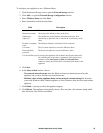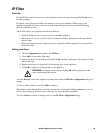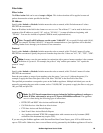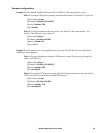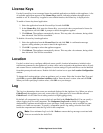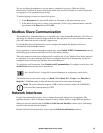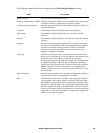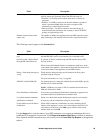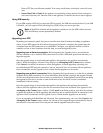
87NetBotz Appliance User’s Guide
You can configure the appliance to post log data to a remote Syslog server. When the Syslog
functionality is enabled, all events stored in the Audit Trail are also forwarded to a remote Syslog host
for logging to a user-specified Syslog facility.
To enable logging of events to a remote Syslog host:
1. In the Hostname field, enter the IP Address or Hostname of the remote Syslog server.
2. If the remote Syslog server is using a port other that 514 for Syslog communications, enter the
port number in the Port field and click OK.
Modbus Slave Communication
The Modbus Slave Communication icon is available only on the NetBotz Rack Monitor 570, 550 or on
appliances for which the Advanced Software Pack has been purchased. For more information, contact
your APC authorized reseller or the APC support team.
Use the Modbus Slave Communication icon to configure the method the appliance will use to
communicate with the Modbus master.
If your appliance is connected through a network port, select Enable TCP/IP Communication. Specify
the listening port in the provided field. Port 502 is the industry default.
The serial connection cannot be configured until a serial device of type "Modbus Slave Serial Interface"
is configured. If you have multiple serial devices configured, the port will automatically use the first
configured device with the type “Modbus Slave Serial Interface”.
To configure a serial connection, select Enable Serial Communication. To configure a serial port, click
Serial Devices and select the device from the list.
See “Serial Devices” on page 99 for more information on configuring a serial device.
The default values for the serial settings are: Baud: 19200, Mode: RTU, Parity: even, Data bits: 8,
Stop bits: 1. The Port setting is inherited from the serial device and cannot be changed.
Note: The serial connection requires a USB-to-Serial converter, such as the USB-RS485
Converter Cable, manufactured by FTDI.
Network Interfaces
Use the Network Interfaces icon to view or change the network settings for your appliance. The
appliance includes a built-in Ethernet connection, and by default, there is a single Ethernet Interface.
When you select an interface and click Edit, the Edit Network Interface window opens with settings
specific to the selected network interface.
Double-click the Network Interfaces icon to open the Edit Network Interface window.



